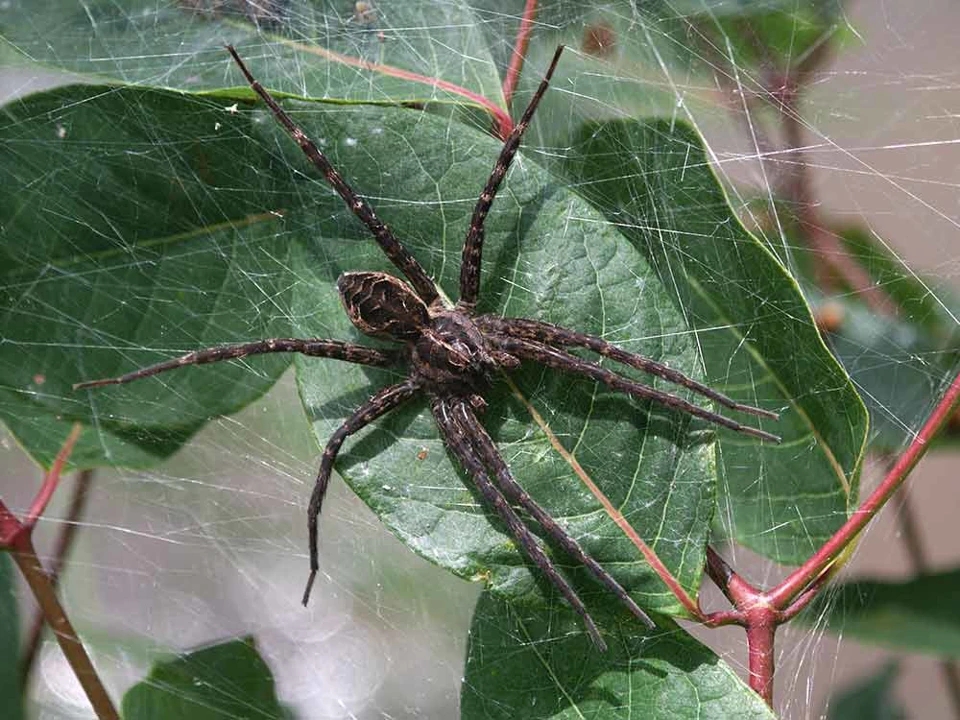
Fishing Spiders belong to the Pisauridae family which includes the Nursery Web spiders. They are often mistaken for Wolf Spiders but can be distinguished by their colouring and number of eyes. Pisaurids have their eyes arranged in 2 rows, the posterior row slightly recurved, the median eyes in the second row slightly (if any) larger than the others. (Wolf spiders have eyes arranged in 3 rows).
There are several types of Fishing Spiders – Dolomedes tenebrosus, Dolomedes Triton, Dolomedes albineus, Dolomedes striatus, Dolomedes vittatus and the Giant Fishing Spider.
Dolomedes tenebrosus – The large female Dolomedes tenebrosus has a body (cephalothorax and abdomen) that reaches about 1” long. When outstretched legs are included in the measurements, it can measure over 3” long. Males are about half this size. The body is a mixture of light brown and light and dark gray.
The legs have dark rings and long spines. The abdomen has 3 conspicuous black W-shaped marks, each of which ends in a light brown mark. This species occurs from southern Canada south to Florida and west to Texas and the Dakotas. Adults can be found throughout late spring and summer. The spiders tend to lurk in corners and crevices during the day, and they hunt actively after dark.
Actual Size: Females:15 mm to 26 mm; Males: 7 mm to 13 mm
Characteristics: Large; brownish-gray in color with black and light brown markings.
Legs: 8
Habitat: Prefers wooded areas. Lives in and around swimming pools, entering homes through cracks in damaged foundations.
Habits:
- Similar to wolf spiders, but have the ability to swim.
- Can dive to deter predators and remain underwater for a short time.
- Attract attention as they can walk across the surface of a pool or stream.
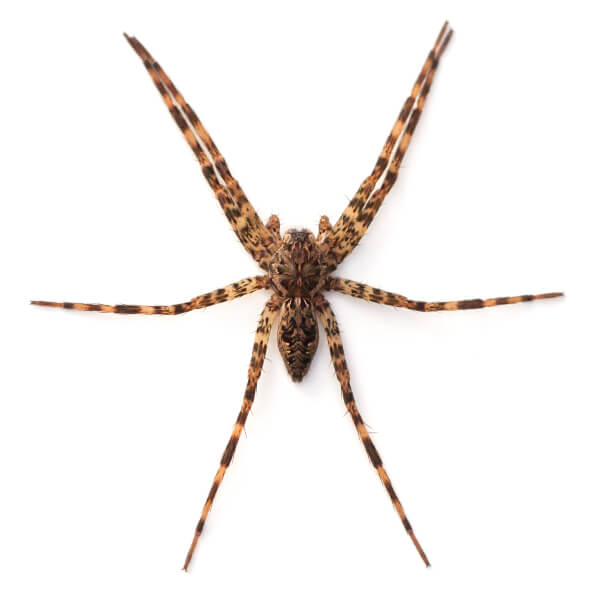
North American pisaurids are all wandering spiders, stalking their prey rather than snaring it in webs. The members of the genus Dolomedes are the “fishing spiders.” Unlike wolf spiders, which they resemble in their giant size, they typically live near water. They run freely over water in pursuit of prey, including small fish and aquatic insects. When frightened, they may dive beneath the surface. Dolomedes tenebrosus are, however, opportunistic, generalist feeders, and they have even been known to consume slugs despite their sticky mucous . Usual habitats for D. tenebrosus are swamp, pond, and lake margins, where it may be found on tree trunks, rocks, logs, and similar situations. Individuals are also found in dark and damp situations beneath bridges or culverts, or in rock piles. Although the Dolomedes tenebrosus is often found near water, this species is not as well adapted to an aquatic environment as some other Dolomedes species. Individuals sometimes stray quite far from water and may even be found in dry wooded areas. Some individuals enter houses, where they may be found in basements, kitchens, and even bedrooms. Although fishing spiders are big enough to give a painful bite, they are not considered dangerous.
Giant Fishing Spider – The genus Ancylometes contains 15 species at the moment counting some of the largest araneomorph spiders, like the A. rufus: adult females which measure 4 – 5 cm in body and more than 10 – 12 cm as legspan; the males are smaller, with about 2.5 – 3 cm body but with longer legs.
Both are brown with dark spots on the abdomen. Males have two thin clear lines all along the carapace, very evident pedipalps and longer legs. Juveniles are pretty similar to adults but external sex determination is sure only in the last moults when patterns on carapace, abdomen and pedipalps shape become visible.
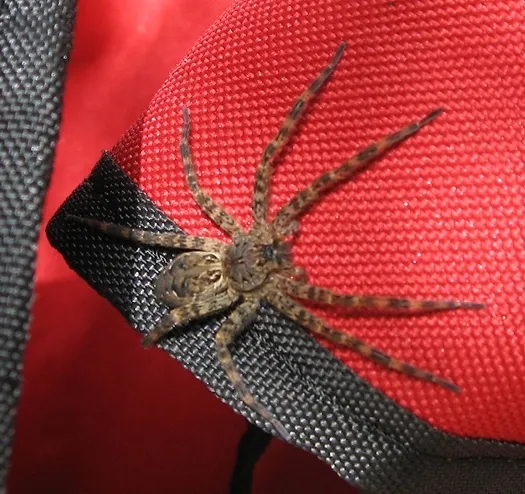
What Do Fishing Spiders Look Like?
Fishing spiders are large, robust spiders often mistaken for wolf spiders due to their size and markings. They typically have a leg span of up to 3 inches and are brown or gray with darker markings. A key identifying feature of this spider species is their ability to walk on water and dive beneath it. Their bodies are covered with small, velvety hairs.
Signs of a Fishing Spider Infestation
While fishing spiders are typically solitary, signs of an infestation include frequent sightings of these large spiders in and around homes, particularly near water sources. Finding their large, sheet-like webs in moist areas can also indicate their presence.
Habitat, Diet, Life Cycle & Bites
Where Do Fishing Spiders Live?
Fishing Spiders typically inhabit areas near bodies of water such as ponds, streams, lakes, and wetlands. They are also found in wooded areas and are sometimes spotted in gardens or homes.
Adept at hunting near and on the water surface, Fishing Spiders often catch small fish and aquatic insects and are known for their ability to walk on water and even dive underneath to capture prey. Their presence near water bodies is a key aspect of their survival and hunting strategy, making them a common sight in aquatic or semi-aquatic environments.
Diet of a Fishing Spider
Fishing spiders primarily feed on small aquatic insects, tadpoles, and even small fish. They have the unique ability to hunt both on water surfaces and underwater, making them versatile predators.
Life Cycle of a Fishing Spider
The life cycle of fishing spiders begins with the female laying eggs and wrapping them in a silk sac. She carries the sac with her until the spiderlings hatch. The young spiders undergo several molts before reaching maturity.
Fishing Spider Bites
Fishing spiders may be large and look menacing, however, their venom is not toxic to humans. They are not household pests, but for those who suffer from arachnophobia, the sight of one of these robust pests can be cause for alarm.
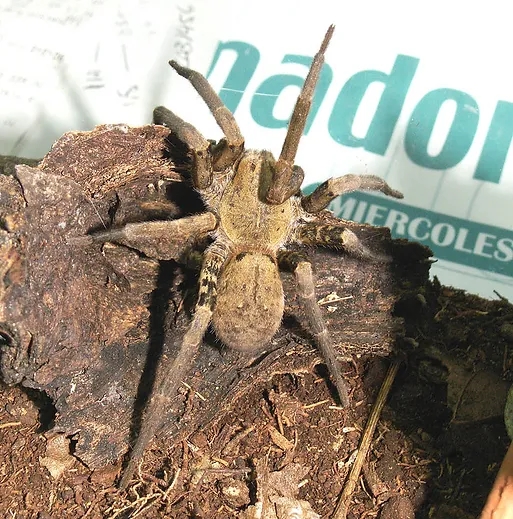
Are Fishing Spiders Dangerous?
Fishing spiders are not considered dangerous to humans. They are non-aggressive and their venom is not harmful to humans, though a bite may cause temporary discomfort.
How to Get Rid of Fishing Spiders?
To get rid of fishing spiders, maintain cleanliness around ponds and wetlands to eliminate their favored habitats. For indoors, minimize moisture to create inhospitable conditions. Regularly clean and declutter spaces to deter fishing spiders. If this persists contact us today for our professional spider removal services.
Fishing Spider Prevention Tips
To prevent fishing spiders, maintain a dry environment in and around your home. Fix leaks promptly, ensure effective drainage around your home, and use dehumidifiers in damp areas like basements. Regularly inspect and seal entry points. These preventive measures create conditions that are less favorable for fishing spiders, reducing the likelihood of their presence in your living spaces.
Fishing Spider: An Intensive Dive into Nature’s Diverse Web-Weaver
The world of spiders is a complex and fascinating one, housing an array of species with unique characteristics and intriguing habits. Among this diversity, the Fishing Spider stands out due to its distinct aquatic lifestyle and impressive size. This article presents an in-depth exploration into the life and habits of this intriguing arachnid.
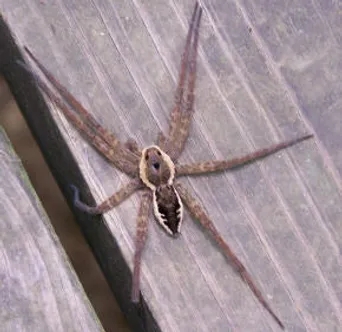
1. Understanding the Fishing Spider
1.1 Identification & Physical Characteristics
Fishing Spiders are distinguished members of the genus Dolomedes, primarily found near water bodies such as ponds, lakes, and streams. Their name ensues from their unique hunting behavior. They sit on the edge of a body of water, patiently waiting for prey to approach within striking distance, then swiftly snatch it up with their long, robust legs.
Adult females of the species can grow to an impressive size, with bodies reaching over an inch in length and leg spans extending over 3 inches. These spiders are predominantly covered in deep shades of brown, black, and dark brown, sometimes accompanied by bands of colors or markings across their bodies.
The physical characteristics and coloration of Fishing Spiders enable them to blend seamlessly with their surroundings, making them masters of camouflage. This attribute, coupled with their hunting prowess, makes them formidable predators in their habitat.
1.2 Habitat & Distribution
Fishing Spiders are habitat generalists, found in a variety of environments. However, they are most commonly sighted in wetlands, woodlands, and in proximity to water bodies. They can be found across the globe, inhabiting various climates, predominantly in Asia, North America, and Europe. They often build their webs near water sources, serving as protective barriers for their eggs.
2. Behavioral Traits of the Fishing Spider
Fishing Spiders are known for their unique behavioral traits, which set them apart from other spider species. Their hunting skills, nocturnal nature, and maternal instincts contribute to their survival and success in the wild.
2.1 Hunting Skills & Diet
Fishing Spiders are efficient predators. Their diet predominantly comprises insects and small fish. They use their keen sense of touch and taste to locate prey, then pounce on it with lightning speed. Their venomous bite is potent enough to kill small prey like insects and even frogs.
When hunting at the water’s edge, Fishing Spiders anchor their rear six legs to a dock or plant and keep their front legs on the water’s surface. Fish, tadpoles, or insects that disturb the water surface are instantly attacked.
2.2 Nocturnal Nature
Fishing Spiders are primarily nocturnal creatures. While they are not shy about feeding by day, they are most active and efficient hunters after sunset. A red reptile night bulb can be an excellent aid for observing their nocturnal activities.
2.3 Maternal Instincts
Female Fishing Spiders exhibit strong maternal instincts. They carry their egg cases, which may contain up to 1,400 eggs, suspended between their fangs, pedipalps, and spinnerets. At the end of the incubation period, the female constructs a web, suspending the egg mass within it. She stays with the hatchlings for a while, defending them against predators.
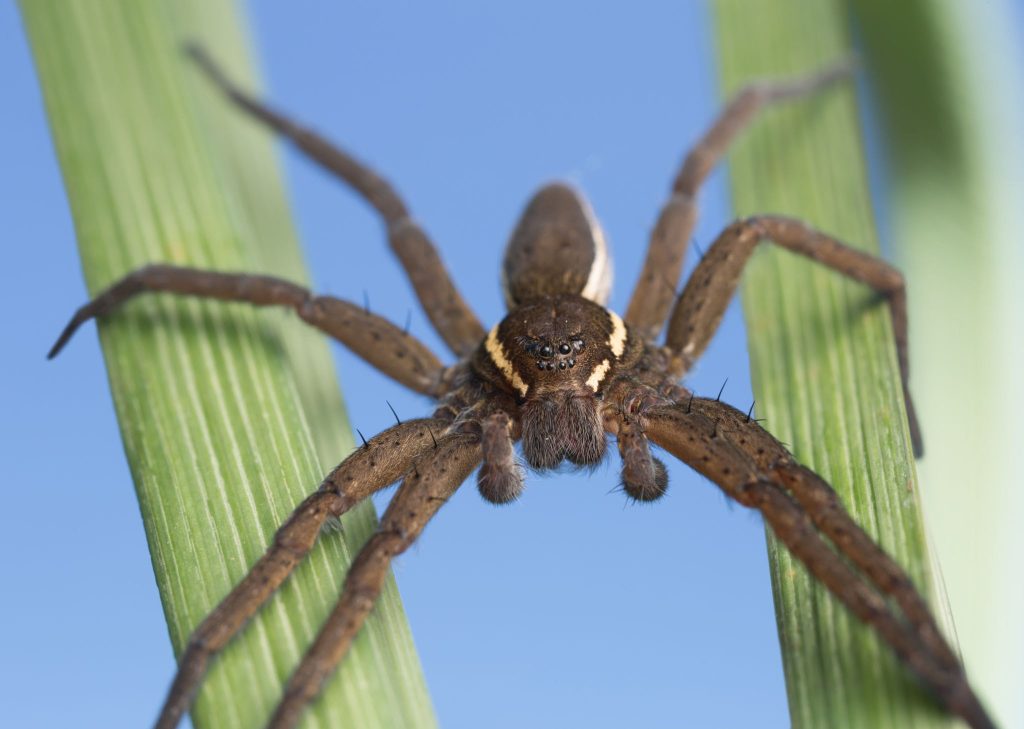
3. Fishing Spider Reproduction & Life Cycle
Fishing Spiders typically reproduce once a year, usually in the late summer or early fall. The males spin a web and then vibrate it to attract females. If a female is interested, she will approach the male, and they will mate.
3.1 Mating Ritual
The male deposits his sperm into the female’s reproductive system during mating. The males generally die after depositing the sperm due to swelling of their genitals.
3.2 Egg Laying & Hatchlings
The female Fishing Spider typically lays over 1,000 eggs at a time. The eggs are laid in an egg sac, which the female spider carries around by attaching to her body until a few days before the eggs hatch. Then, she builds a nursery using her webbing to keep the eggs safe before they hatch.
3.3 Lifespan
Fishing Spiders are known to have a relatively long lifespan for spiders, living up to 2-3 years in the wild. However, they face many threats during their lifetime, including predators, disease, and environmental changes.
4. Fishing Spider Predators & Threats
Fishing Spiders are preyed upon by larger animals like birds or snakes. Some arthropod species, such as centipedes and scorpions, may also prey on the Fishing Spider. Other predators of the Fishing Spider can include bats, large frogs, and fish.
The primary predator of Fishing Spiders is the bird known as the kingfisher. Kingfishers are small to medium-sized birds with large heads, long bills, and short legs that are known for hunting fish. They are excellent hunters and can spot a Fishing Spider from a distance as it sits on a leaf or twig near water.
5. Interesting Facts about Fishing Spiders
Here are some intriguing facts about Fishing Spiders:
- Fishing spiders are members of the Pisauridae family and are also known as raft spiders, wharf spiders, or dock spiders.
- They can walk on water, thanks to the waxy substance covering their legs, which makes them waterproof.
- Fishing spiders can be very large, with some species reaching up to 4 inches in leg span.
- These spiders can be found all over the world in both temperate and tropical climates.
- Fishing spiders are venomous, but their bites do not harm humans.
6. Fishing Spider vs. Other Similar Species
Fishing Spiders are sometimes confused with other species due to their similar appearances:
- Wolf Spider: Fishing Spiders are often mistaken for Wolf Spiders due to their large size and horizontal rows of eyes. However, a Fishing Spider is distinguished by its larger size and aquatic lifestyle.
- Pond Skater: These insects also live in or around water and can glide across the surface, much like Fishing Spiders.
- Water Beetle: These beetles live in waters all around the world, similar to Fishing Spiders.
7. Fishing Spider Care
While Fishing Spiders are generally quite shy around humans, they will not hesitate to bite if they feel threatened or are mishandled. Their bites can be compared to a bee sting, so while they do hurt, they are not dangerous to humans.
If you’re thinking about keeping a Fishing Spider as a pet, it’s essential to provide them with a suitable habitat. They require a large terrarium with plenty of space, live plants, upright cork bark slabs, and a small pool of water.
8. Fishing Spider Conservation Status
Fishing Spiders are not considered endangered or threatened at this time. They are a vital part of the ecosystem and help control insect populations. The population of Fishing Spiders varies depending on the location and can be difficult to calculate, but they appear to be doing well overall.
9. Fishing Spider in Pop Culture
Despite their fascinating characteristics, Fishing Spiders are not as well-known or popular as some other spider species in popular culture. However, they are often the subject of study for scientists and researchers due to their unique behavior and hunting skills.
10. Fishing Spider: Friend or Foe?
While the sight of a large Fishing Spider might be intimidating to some, it’s important to remember that they are generally harmless to humans. They are beneficial creatures, helping to control insect populations and maintaining the health of their ecosystems. By understanding these creatures, we can appreciate their role in nature rather than fearing them.
11. Fishing Spider FAQs
Here are some frequently asked questions about Fishing Spiders:
- Are fishing spiders monogamous? Male fishing spiders can be considered monogamous as they only have one chance to breed before dying.
- What is the average lifespan of a fishing spider? The average lifespan of a fishing spider is 2-3 years.
- Can fishing spiders hurt you? Fishing spiders are generally quite shy around humans, so they won’t attack. However, if they do bite you, the bite can be compared to a bee sting. So, while they do hurt, they are not dangerous to humans.
- Do fishing spiders eat fish? The majority of the diet of a fishing spider is insects, but they have been known to eat smaller fish species, as these spiders are opportunistic feeders.
Fishing Spiders are fascinating creatures with a unique set of behaviors and adaptations that set them apart from other spider species. Their ability to walk on water, hunt both insects and fish, and their maternal instincts make them an intriguing subject of study. By understanding and appreciating these creatures, we can learn to coexist with them and appreciate their role in maintaining the balance of our ecosystems.
